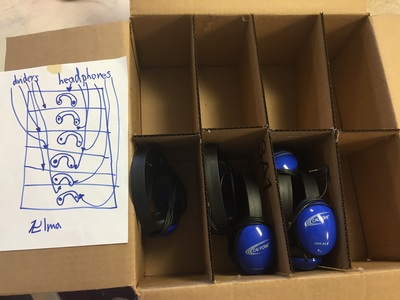One of the ways we've been connecting real-world problem-solving to making is by engaging students around "design team challenges" provided by our faculty and staff. We asked faculty and staff to submit videos of themselves asking for something to be fixed, built, or invented by our students to improve the classroom or school-wide experience. We received an intriguing list of ideas including rainwater diverters, 3D models of the new buildings, and portable sound booths.
We decided to start with a problem that exists in Ms. Sedlock's 2nd grade classroom: how to neatly and efficiently store eleven sets of headphones. Students had been stacking them up in a crate but the cords were getting tangled and Ms. Sedlock figured there had to be a better way.
We invited students in grades two through eight to join us during lunch to participate in a process guided by the Stanford d.school and IDEO's Design Thinking concepts:
We decided to start with a problem that exists in Ms. Sedlock's 2nd grade classroom: how to neatly and efficiently store eleven sets of headphones. Students had been stacking them up in a crate but the cords were getting tangled and Ms. Sedlock figured there had to be a better way.
We invited students in grades two through eight to join us during lunch to participate in a process guided by the Stanford d.school and IDEO's Design Thinking concepts:
To begin, we showed students this video so they could understand the problem and empathize with what was needed and why:
We then had students ideate by sketching designs for possible solutions to the problem. Students provided feedback to each other during a "gallery walk" by using "I like..." or "I wonder..." statements to show appreciation or further each other's ideas.
As a group, we discussed the variety of approaches and selected two designs to build into prototypes (sample models). Students then used the available materials in the Open Lab to create mockups of two possible solutions:
After several lunch periods, the mostly second graders (as well as a few 3rd and 4th graders) were ready to share their builds with Ms. Sedlock. She was invited to come back to see and comment on these prototypes. She was quite pleased with the student designs and offered suggestions for finalizing them.
Here is the final version along with the original design sketch:
It holds four large headphones on external hooks and seven small headphones on internal hooks. Each set of headphones is easy to access and store. Students also provided a recommended method for wrapping the cords.
— Tatian Greenleaf
— Tatian Greenleaf








 RSS Feed
RSS Feed
